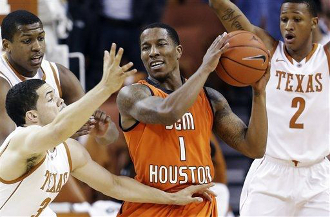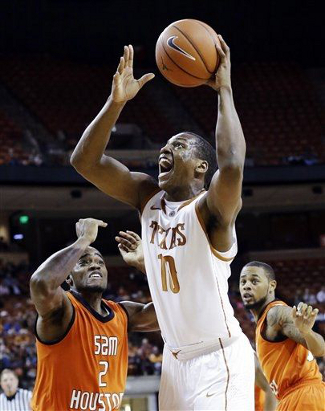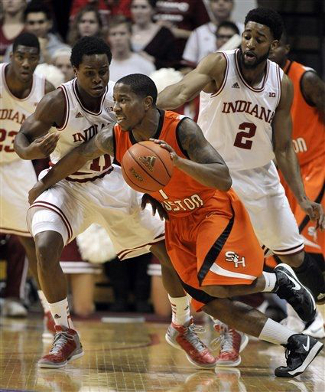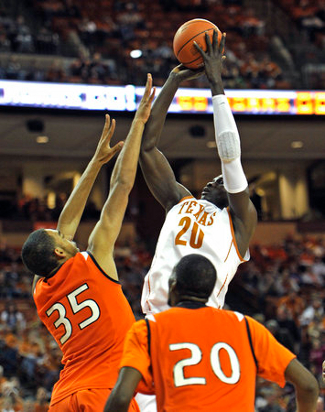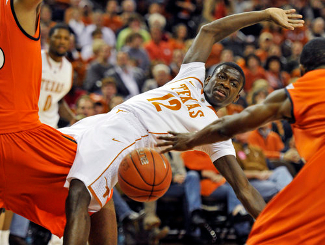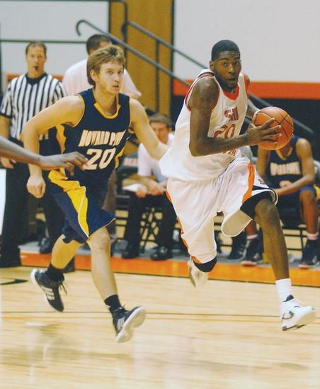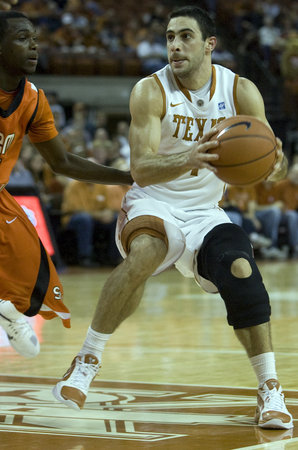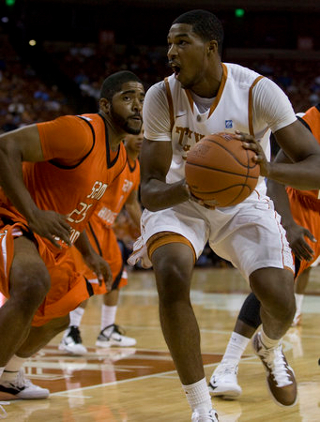After a harrowing week of basketball on the island of Maui, the Texas Longhorns returned to mainland action on Tuesday night, hoping for a quick recovery against Sam Houston State. Led by a stifling defensive performance, the Longhorns overcame 19 turnovers and long field goal droughts to cruise to a 28-point win.
Sam Houston State was suffocated by the Texas defense Texas limited the Bearkats to only 0.506 points per possession on the night, while allowing just 21% shooting from the field. The Longhorns used excellent team defense and mixed in a variety of looks and lineup combinations to keep Sam Houston State frustrated throughout. That defensive dominance was never more apparent than in a stretch of eight-plus minutes, spanning both halves, in which the Bearkats managed just one field goal. Texas stifled their opponents with sound man defense in the first half, hedging hard on ball screens while using a larger lineup. Facing a four-out, one-in look from the smaller Bearkats, Coach Rick Barnes elected to go with a smaller lineup of his own during the first half and the Longhorns began switching screens. In the second half, big man Cameron Ridley saw much more action as the Longhorns shifted into a zone defense that was just as effective. One of the most impressive players on the defensive end was freshman Demarcus Holland, who earned his first career start. In his 26 minutes on the court, only four points were scored by players he was guarding. The first bucket came as Sam Houston State rushed down the court and Holland couldn’t find his man, Paul Baxter, who dribbled through traffic before drilling a pull-up jumper from the free-throw line. The other basket came when the 6’2″ Holland was isolated on the block against 6’7″ Erik Williams. Even then, Holland played solid belly-up defense and kept his arms straight up, forcing Williams to take a hook shot as he stepped across the lane. Demarcus seemed to be making the little plays all night long. In one instance, he bailed out Ioannis Papapetrou, who allowed James Thomas past him on a drive from the wing. Holland swiped at the ball, forcing Thomas to bobble it and ultimately travel along the baseline. Later in the game, Papi returned the favor for his teammate, standing tall to get a blocked shot after Holland was hung up on a screen at the free throw line. Holland also snagged five defensive rebounds, many of them coming as he sagged off to help from the weak side. Offensively, Demarcus did not perform nearly as well. He missed one three-point attempt and had another one blocked, and he missed his two other shots on the night. He did score five points from the line, earning four of his seven free throw attempts by hustling for loose balls and rebounds. However, Holland was tagged with two turnovers for the game, one coming on an ugly pass at the end of the first half and the other coming when he simply held the ball in front of the aggressive Darius Gatson well behind the arc. Those turnovers were once again a problem for the entire team, with the Longhorns losing it on 26% of their possessions. That number is ugly on its own merits, but when you consider that 26% is actually an improvement from the last game against Mississippi State, the scope of the problem becomes more overwhelming. The most frustrating aspect is that many of the Texas turnovers happen because of a lack of awareness by players off the ball, while quite a few others come from making lazy passes. Javan Felix turned it over on a five-second call where he stood at least five feet behind the arc, while the rest of his team waited idly around the lane. Texas also lost one on a five-second call on an inbounds play where the Bearkats doubled to deny the pass, while no other Longhorns came back to help. When starting the offense, passes between the two guards at the top of the key are far too often deflected or nearly stolen. This has been a problem all season long, and it was once again an issue against the Bearkats. Papapetrou has had numerous soft passes stolen as he gives the ball back to Felix, while Javan has given it away on simple passes to the wings. In this game, Felix was responsible for five turnovers, and could have had a sixth if the Bearkats had held on to one of his telegraphed passes to Holland on the wing. Another recurring issue for the Longhorns is poor decision-making in the transition game. Texas has the athletes to get out and run, and with an offense that is struggling in half-court sets, easy transition opportunities cannot be wasted. Sheldon McClellan blew two of those chances in this game, while Holland spoiled another. McClellan barreled ahead in a two-on-three situation, trying to sidestep a charge before missing his layup. Later in the game, he had it poked away from behind as he sized up a one-on-one move. No team wants to waste their fast breaks, but an offense as inefficient as Texas’ certainly cannot afford to do so. Although McClellan wasted those two opportunities, he did manage to lead the team with 16 points. Unfortunately, that came on 4-of-13 shooting, with six of those misses coming from inside the arc. Texas has had a lot of success finding Sheldon on baseline inbounds plays this season, and the same was true in this game. Using a different set from the one they repeatedly abused Mississippi State with, the Longhorns hit McClellan for a wide-open three on one baseline inbounds, one of the two triples he hit on the night. McClellan came off the bench for the third consecutive game, as Coach Barnes continued to send the sophomore a message about effort, particularly on the defensive end. He ended up playing 28 minutes and contributing to the solid team D, although he did lose sharpshooter Will Bond in transition on one play, allowing him to hit his only three of the game.
Jonathan Holmes found some success inside In addition to freeing up McClellan on inbounds passes, Texas also did a good job isolating Jonathan Holmes on the blocks and finding him for easy buckets. While the young Longhorns are still struggling to get the ball into the post, Holmes was the recipient of two nice feeds for points in the paint. He also added a three-point bucket and a nice stickback on an offensive rebound that he grabbed despite being out of position. Unfortunately, those issues with hitting the post players have cost Texas quite a few points this season. Many post feeds have been thrown at bad angles or zipped past the bigs far too quickly. Other times, the Longhorn guards and wings have just been completely oblivious to a wide-open teammate who has worked hard to get to the right spot on the floor. While the turnover problems are clearly the biggest issue right now for Texas, this certainly must also be high on the priority list for the coaching staff. The Longhorn coaches will also be concerned by the team’s performance on the glass, as once again Texas could not exploit a significant size advantage. The Horns grabbed only 22.6% of their offensive rebounding opportunities, which was a huge reason why they could only manage a dismal 0.88 points per possession. Fortunately, it is clear that rebounding was a big talking point at halftime, and that the team responded to that message. The Bearkats held a 21-18 edge on the glass at half, but Texas turned the tables after the break, outrebounding Sam Houston State by a 29-14 count in the second twenty minutes. The Longhorns also had a nice second-half effort from Julien Lewis, who picked up two early fouls and was limited to just 19 minutes for the game. He came out of the locker room and made an aggressive drive to earn two quick free throws in the second half, then followed it up with a nice backcut for a reverse layup and the foul. He also made a strong baseline drive later in the half to draw the defense and free up Ridley on the block, and he earned eight trips to the line with his constant dribble penetration. Prince Ibeh also made a nice contribution in his limited minutes. Once again, he impacted plays inside by altering shots and keeping rebounding opportunities alive for teammates by tipping balls that were just out of his reach. More important, however, were the two strong, quick moves he made after receiving feeds in the post. After looking panicked with the ball in Maui, where he repeatedly allowed defenses to collapse on him as he froze up, seeing Ibeh exhibit some confidence is a welcome change for Texas fans. With one more tune-up awaiting on Saturday before daunting games against Georgetown and UCLA, the Longhorns have to hope for even more improvement throughout this week of practice. Although shots weren’t falling for long stretches of the game, there were quite a few possessions where the Longhorns made nice, hard cuts and set solid screens to get the offense going. Although the effort waned throughout the game, it’s clear that some steps are being made in the right direction. Texas fans can only hope that those improvements both continue and accelerate in the coming days. Up next: vs. UT-Arlington; 3 P.M. CT, Saturday |








